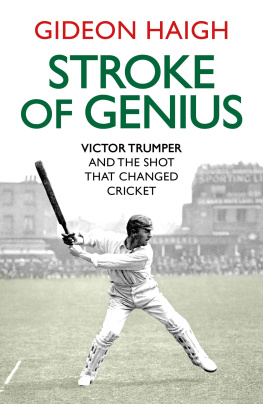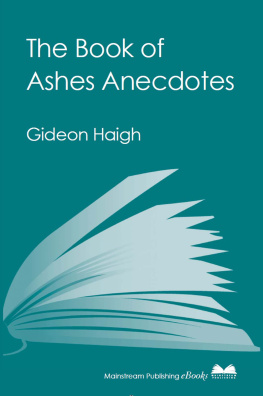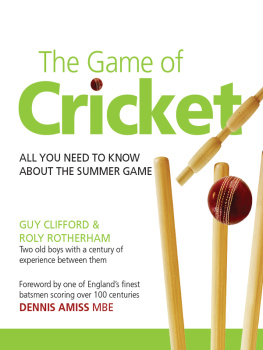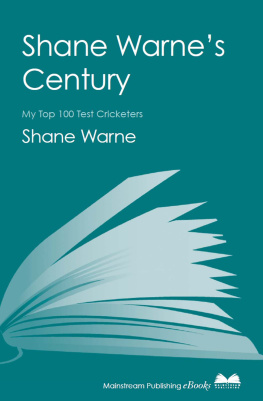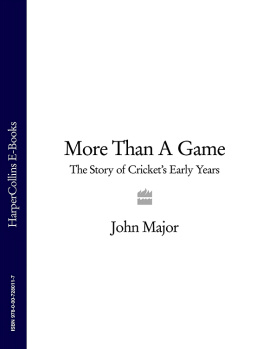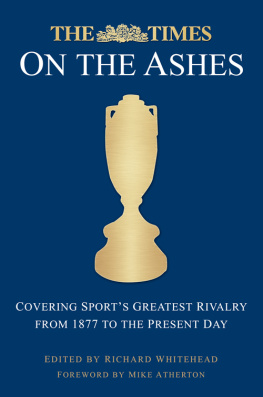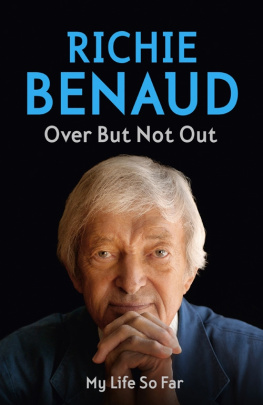
Gideon Haigh is the author of Mystery Spinner, which was Cricket Society Book of the Year, shortlisted for the William Hill Sports Book of the Year and acclaimed as a classic by the Sunday Times; The Big Ship, a biography of Warwick Armstrong; Many a Slip, his diary of a club cricket season; and Bad Company, a study of the phenomenon of the CEO all of which are published by Aurum. He writes regularly for the Guardian, as well as for The Times and the Financial Times. He lives in Melbourne, Australia.
W HEN THE A MERICAN SHORT STORY WRITER Ring Lardner died, young, after a career that never quite fulfilled its rich promise, E Scott Fitzgerald was quick to finger the culprit. Lardner, he pointed out, had poured much of his youthful energy into working as a beat reporter for the Chicago Inter-Ocean following the Cubs and White Sox, and thus down the drain of sports journalism: During those years when most men and women of promise achieve an adult education, Ring moved in the company of a few dozen illiterates playing a boys game. A boys game, with no more possibilities in it than a boy could master, a game bounded by walls which kept out novelty or danger, change or adventure. So there.
In the years I have written about cricket, Fitzgeralds admonition has always had a faintly familiar ring. Why bother doing it? Would there not be more gainful avenues for expression? At book launches and literary events, a hint of condescension lurks behind the smiles. Still writing about cricket, eh? Oh dear. There is even, at times, a hint of resentment, sport in Australia being seen as somehow antagonistic to culture, an alternative to thought, an opiate of the people. A curious country, this where it is often those boasting loudest of their demotic sympathies who are most inclined to dismiss the widely enjoyed as base, vulgar and jejune.
Which is not to say that these questions are without force. Yes indeed: why do it? When I ask any of the scores of young people Ive met aspiring to careers writing about sport for newspapers, the answer is always invariable: Because I love sport. I cringe inwardly at this; perhaps the only answer worse is: Because I love writing. It isnt that enjoyment always ceases once one turns a pleasure into a job; but ones relationship to that pleasure changes. When I meet them again down the track, they have usually become either bored or boring, surfeited and cynical or capable of discussing nothing else chewed up and spat out or chewed up and swallowed.
Looking back, even if I was incapable of articulating it, I think Ive always had in mind the possibility of such a fate. It was love at first sight when I found cricket. Ive tried not to jeopardise the relationship. I still play it, humbly, and enjoy it, greatly. Thus Ive shrunk from making cricket my job: where Ive written, its usually been because Ive had something to say, or at least to add, wished to share it, and thought it time well spent. Its meant to be fun, isnt it? Were doing this because we want to, right? Ive always liked a story about a conversation between Gubby Allen, who between captaining England and being a grandee of Lords worked in the City, and his Middlesex colleague John Warr. If I had devoted as much time to stockbroking as I had to English cricket, Allen declared loftily one day, I should probably have been a millionaire by now. Warr hastily assented. Yes, he said. And just think how much better off English cricket would have been.
This book collects some of my cricket journalism from the last five years the stuff, anyway, that its not too shaming to revisit, and hasnt been rendered redundant by that terror of the sportswriter, glorious uncertainty plus a couple of earlier pieces. A few have been published in Australia before; most have not, being commissioned from England, India and Pakistan. There are studies of players old and new, essays exploring past events and present discontents, satisfactions of my own curiosity and responses to events of the day. Some subjects I have tackled several times, such as Sir Donald Bradmans apotheosis and Hansie Cronjes disgrace. One section addresses lesser cricketers who, for various reasons, have become personal favourites, from Ranji Hordern to Mohinder Amarnath. Another concerns writing and broadcasting, including perspectives on five cricket critics I admire and one I do not. The Yarras, my club, lurk in the background. A few of these pieces made their first appearance in the club newsletter of which Im editor still my longest permanent cricket-writing role. But to quote Ring Lardner himself, at the start of his wonderful short story of sport and journalism Harmony: Even a baseball writer must sometimes work.
Gideon Haigh
Melbourne, August 2004
Behind every piece in this book has stood an editor, sometimes pleased, sometimes puzzled, but usually good-humoured: Stephen Fay, Sambit Bal, Chris Ryan, John Stern, Graem Sims, Graeme Wright, Peter Hanlon, Warwick Franks, Rob Steen, Guy Rundle, Peter Rose, Max Suich, Sally Heath, Kathy Bail and Garrie Hutchinson. Special thanks are due to Malcolm Schmidtke, who eased my first faltering steps in journalism, and David Frith, whos forgotten more about cricket than Ill ever know. I benefited, as always, from Philippa Hawkers critical clarity and George Thomass eagle eye when they read the manuscript. Its been another enjoyable and trouble-free experience to publish with Morry Schwartz and Black Inc: that is, Rebecca Arnold, Eugenie Baulch, Thomas Deverall, Chris Feik, Roisin FitzGerald, Meredith Kelly, Sophy Williams and Caitlin Yates.
The confidence with which many of the judgements in this book have been made testifies to how easy cricket is when perched behind a laptop. I am grateful to my comrades at the Yarras for tolerating my efforts to bridge the gulf between talking and doing, and to my partner Sally Warhaft for dealing with the frustrations that flow from my repeated failures to do so. In all areas other than sport, she has hugely enriched my life. I dedicate this book to her, in lieu temporarily, I promise of a summer holiday.
F OR ALL THE BOOKS that have purported to document the history of cricket, there is much about its past we do not know, and probably never will.
The bat has been explained as a development of a shepherds crook for not much more reason than it looks like a shepherds crook; of the choice of leather, cork and wool to make the ball, we can say little more than that these were the available materials. Two stumps are first mentioned in 1680, and a third appears in a picture a century later, even though it wasnt officially necessary until 1838. How was it decided we bowl with a rigid arm, and to play in opposite directions in alternate overs? Brilliant ideas, both of them, the former encouraging innovation to challenge the rigidity of the requirement, the latter introducing chance and variety by granting environmental degradation an influence on a matchs unfolding but who to credit with them?
Above all, why did cricket catch on? The world abounds in games that dont, or do then die: crickets popularity in places and with people so far from its origins is a source of ineradicable wonder. For sure, cricket can look spectacular, yet its not geared to spectacle; it can be entertaining, but its not really an entertainment. The main action takes place further from watchers than in any other sport, while the density and sophistication of its laws and techniques make few concessions to the uninitiated. Were you to design a game with modern mores in mind, in fact, the last thing youd come up with would be convoluted, opaque, prolonged, sometimes ungainly, often slow-moving cricket. And yet, here we are, still playing, and seldom crazier for it.
Next page


